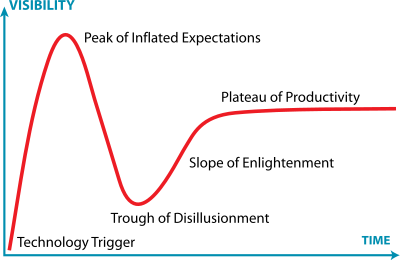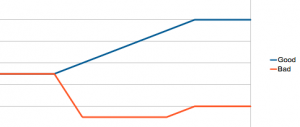Most of have seen the Gartner hype cycle graph – shown here from wikipedia. This got me thinking about what would happen if we tried to do the same thing – except with trusting our teammates to see how they compare. I’m calling that the “trust cycle.” While we do hear a lot about trust and team in agile, the only place I found using the term “trust cycle” wasDavid Weiss’ blog.
The beginning:
With the hype cycle, we start at basically zero. We haven’t heard of something and we remain skeptical until we hear a little. Then we get too excited.
With the trust cycle, I think you start more in the middle. When you first meet someone, you don’t inherently trust or distrust them. And at the beginning, people are pretty cautious and don’t do anything to change that.
The middle
With the hype cycle, the trigger for change is reality. We go from inflated expectations to seeing what the technology can really do. Since our expectations were too high, we fall harder.
With the the trust cycle, the trigger for change depends on whether it is positive or negative. For positive trust (teambuilding), it just takes time. Our trust level slowly goes up until we trust the person fully. For negative, the jump happens much faster. Either as a series of little things that make you suspicious (as shown in the graph) or as one big thing that causes a series drop. Once we’ve dropped, trust either stays at rock bottom or gets re-earned very slowly.
The end
Both cycles stabilize at the end. The hype cycle stabilizes at reality. The trust cycle stabilizes at either trust or distrust.
Conclusion
This stickyminds article talks about how to build trust. What do you think about the trust cycle?
